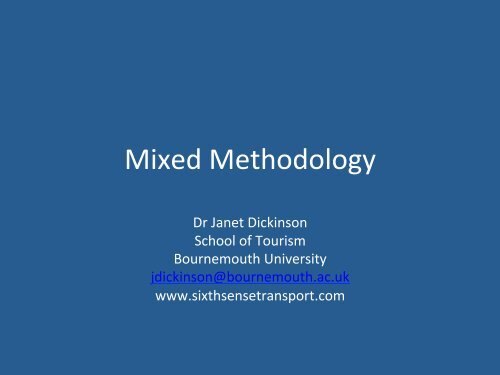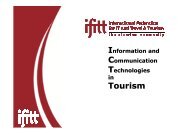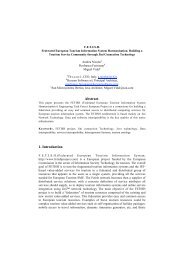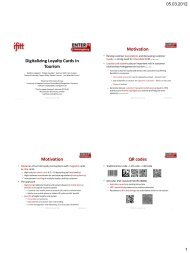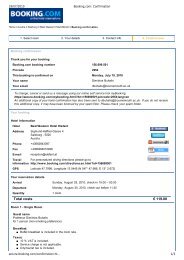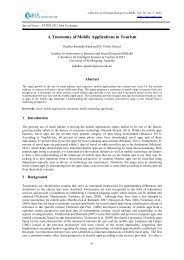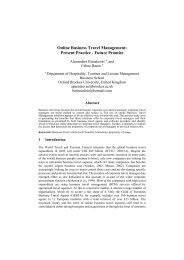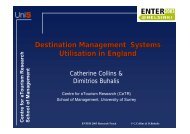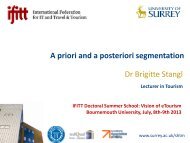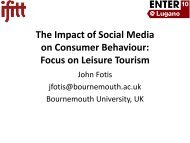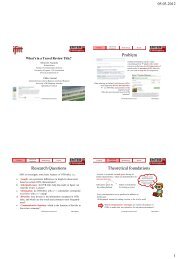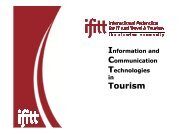Janet Dickinson: Mixed Methodology - IFITT
Janet Dickinson: Mixed Methodology - IFITT
Janet Dickinson: Mixed Methodology - IFITT
Create successful ePaper yourself
Turn your PDF publications into a flip-book with our unique Google optimized e-Paper software.
<strong>Mixed</strong> <strong>Methodology</strong> Dr <strong>Janet</strong> <strong>Dickinson</strong> School of Tourism Bournemouth University jdickinson@bournemouth.ac.uk www.sixthsensetransport.com
The Plan • Method and methodology • <strong>Mixed</strong> methodology raDonale • <strong>Mixed</strong> methodology strategies • Paradigm consideraDons • AcDvity
Method and methodology • What is the difference? – <strong>Methodology</strong> = overall approach – the strategy, method, sampling, analysis, paradigm – Method = Research instrument(s) – the tools you will use • What is mixed methodology – Using more than one method or methodological strategy to beOer address a research problem
<strong>Mixed</strong> methodology raDonale • More holisDc and complete view of the problem • Different elements to the research problem require different approaches • Need for different approaches at different stages • One method is needed to inform the design of another research instrument
<strong>Mixed</strong> methodology strategies • SequenDal • Concurrent • Embedded • MulDphase Can be fixed at the start or emergent in response to project needs (eg a gap in knowledge emerges)
SequenDal example Social representaDons of residents’ and visitors’ mobility paOerns (my PhD) • In-‐depth interviews with local residents to understand the local tourism transport context (qualitaDve) • Tourist generated travel diaries (qual/quant) • Tourist quesDonnaire (quanDtaDve but inducDve analysis strategy)
Concurrent example • Understanding visitor behaviour – GPS tracking – NarraDve interviews – ‘a day in the life of…’
Embedded example • QuesDonnaire survey reveals a significant gender difference • In-‐depth interviews used to explore and understand this difference
MulDphase • Understanding the scope for tourist collaboraDon using a smartphone app – Phase 1: In-‐depth interviews – used to inform app design – Phase 2 (a separate study): quesDonnaire – used to analyse collaboraDon concepts and if these vary by tourist context
How is analysis conducted? • Depends on the strategy – Merging data, oben in a discussion – ConnecDng data (eg in sequenDal design) – Embedding data (eg qualitaDve study is used to explain a finding of quanDtaDve study)
Paradigm consideraDons • Conflict in paradigm • Researchers pre-‐disposiDon to parDcular paradigms (I think you need to get over it!) • Oben set in pragmaDst paradigm – Is this a cop out? • Important to sDll be able to arDculate overall ontology and epistemology
AcDvity – 6ST trial 1. What mixed methodology strategy is used? 2. Map objecDves to methods (ie how can the data answer our research quesDons?) 3. What analysis strategy is appropriate for each method? 4. How can we integrate data and analysis from different methods? 5. What is the role of theory? 6. Which research paradigm?
Final comments • Danger of doing too many things • Take care to map out the research design cycle • Which type of research strategy? • How will you integrate data and analysis? • Think about paradigm – Ontological and epistemological concerns


